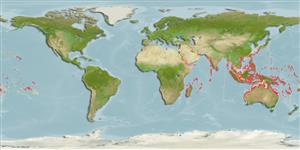Environment: milieu / climate zone / depth range / distribution range
Ecology
Marine; reef-associated; non-migratory; depth range 0 - 30 m (Ref. 58304). Tropical; 36°N - 36°S, 28°E - 132°W
Indo-Pacific: East Africa to the Line and Tuamoto islands, north to southern Japan, south to the Lord Howe and the Austral islands. Closely related to Chaetodon decussatus.
Size / Weight / Age
Maturity: Lm ? range ? - ? cm
Max length : 23.0 cm TL male/unsexed; (Ref. 9710); common length : 15.0 cm TL male/unsexed; (Ref. 5450)
Dorsal spines (total): 13; Dorsal soft rays (total): 23 - 25; Anal spines: 3; Anal soft rays: 19 - 22. This species is distinguished by the following characters: snout length 2.5-3.2 in head length; greatest body depth 1.5-1.7 in SL. Body pattern chevron with narrow lines on side; black band across posterior body which does not include entire rear part of dorsal fin (Ref. 90102).
Adults are found in reef flats, lagoon and seaward reefs and sometimes in turbid waters subject to freshwater runoff swimming in pairs. They are omnivorous, feeding on algae, coral polyps, crustaceans and worms (Ref. 5503). They are oviparous (Ref. 205) and monogamous (Ref. 52884). Stable monogamous pairs with both pair members jointly defending a feeding territory against other pairs (Ref. 58331) occur, but often accompany other species without being aggressive. They are easily maintained in tanks. Minimum depth reported taken from Ref. 128797.
Life cycle and mating behavior
Maturity | Reproduction | Spawning | Eggs | Fecundity | Larvae
Distinct pairing (Ref. 205). Stable monogamous pairs with both pair members jointly defending a feeding territory. Pelagic larvae settle to shallow (<4 m) back reef habitats consisting of rubble, seagrass and low coral cover (Ref. 58331). Monogamous mating is observed as both obligate and social (Ref. 52884).
Myers, R.F., 1991. Micronesian reef fishes. Second Ed. Coral Graphics, Barrigada, Guam. 298 p. (Ref. 1602)
IUCN Red List Status (Ref. 130435: Version 2024-1)
Threat to humans
Harmless
Human uses
Fisheries: minor commercial; aquarium: commercial
Tools
Special reports
Download XML
Internet sources
Estimates based on models
Preferred temperature (Ref.
123201): 24.7 - 29.3, mean 28.4 °C (based on 3294 cells).
Phylogenetic diversity index (Ref.
82804): PD
50 = 0.5000 [Uniqueness, from 0.5 = low to 2.0 = high].
Bayesian length-weight: a=0.02042 (0.01237 - 0.03369), b=2.98 (2.84 - 3.12), in cm total length, based on LWR estimates for this species & Genus-body shape (Ref.
93245).
Trophic level (Ref.
69278): 3.4 ±0.29 se; based on food items.
Resilience (Ref.
120179): High, minimum population doubling time less than 15 months (Preliminary K or Fecundity.).
Fishing Vulnerability (Ref.
59153): Low vulnerability (13 of 100).
Nutrients (Ref.
124155): Calcium = 81.8 [43.3, 126.5] mg/100g; Iron = 0.74 [0.45, 1.17] mg/100g; Protein = 18.5 [17.4, 19.6] %; Omega3 = 0.107 [0.068, 0.165] g/100g; Selenium = 32.4 [18.8, 59.2] μg/100g; VitaminA = 44.8 [13.0, 147.3] μg/100g; Zinc = 1.36 [0.94, 1.94] mg/100g (wet weight);
